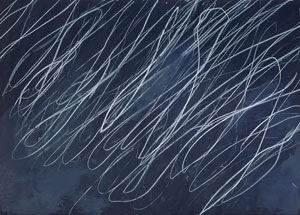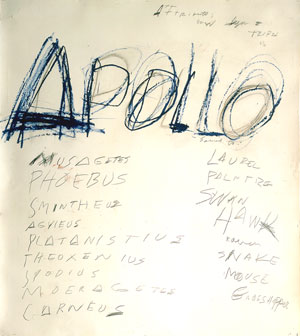Few museums maintain as strong a commitment to a single artist as the Menil Collection does to Cy Twombly.

Cy Twombly... Proteus... 1984 ... Synthetic polymer, colored pencil, and graphite on paper; 29 15/16 x 22
The museum mounted its first Twombly exhibition in 1989, just two years after the opening of its then-new building. Over the past fifteen years, the museum has hosted two more exhibitions of Twombly’s work, both surveys: the Museum of Modern Art’s Cy Twombly: A Retrospective came in 1995, and Cy Twombly: The Sculpture, an in-depth survey of Twombly’s three-dimensional work, in 2001 (co-organized by the Menil and the Kunstmuseum Basel). A free-standing gallery dedicated to a permanent installation of Twombly’s work opened in 1995, the tenth anniversary of which is marked by the Menil’s current exhibition, Cy Twombly: Fifty Years of Works on Paper. This exhibition surveys Twombly’s drawings, collages and paintings on paper through material drawn almost exclusively from the artist’s studio. Originally organized by the State Hermitage Museum, St. Petersburg, Russia to mark the artist’s 75th birthday, the exhibition was expanded for its presentation at the Whitney Museum of American Art earlier this year. Its installation in Houston, through September 4, coincides with Cy Twombly: Lepanto at the Museum of Fine Arts, Houston.
All of this adds up to a lot of opportunities to consider Twombly’s oeuvre; but as Fifty Years of Works on Paper indicates, the Menil may have gone too far in mounting yet another retrospective exhibition of work by Cy Twombly.
The show is installed in rough chronological order, as we might expect from a retrospective, and features work from the 1950s through the present. This overview of the artist’s career, one of the pleasures of a survey exhibition, affords viewers the opportunity to trace the development of some ideas in the work, as well as the abandonment of others, and to speculate on what direction Twombly will take next. For me, however, the unrelenting chronological march through the galleries also made apparent the typically excusable deficiency of any survey — that curators must skim along the surface, selecting work representative of each decade in the artist’s career. This superficiality was noticeable because there have been two such exhibitions at the Menil already, making this retrospective seem more like a thumbnail biography than an in-depth chronicle. Round one of the Menil’s Twombly surveys must have been engaging; round three ends up being a little too predictable.

Cy Twombly... Untitled... 1970... Wax crayon and house paint on paper; 27 3/4 x 39 3/8 in. (70.5 x 100
Few museums maintain as strong a commitment to a single artist as the Menil Collection does to Cy Twombly. The museum mounted its first Twombly exhibition in 1989, just two years after the opening of its then-new building. Over the past fifteen years, the museum has hosted two more exhibitions of Twombly’s work, both surveys: the Museum of Modern Art’s Cy Twombly: A Retrospective came in 1995, and Cy Twombly: The Sculpture, an in-depth survey of Twombly’s three-dimensional work, in 2001 (co-organized by the Menil and the Kunstmuseum Basel). A free-standing gallery dedicated to a permanent installation of Twombly’s work opened in 1995, the tenth anniversary of which is marked by the Menil’s current exhibition, Cy Twombly: Fifty Years of Works on Paper. This exhibition surveys Twombly’s drawings, collages and paintings on paper through material drawn almost exclusively from the artist’s studio. Originally organized by the State Hermitage Museum, St. Petersburg, Russia to mark the artist’s 75th birthday, the exhibition was expanded for its presentation at the Whitney Museum of American Art earlier this year. Its installation in Houston, through September 4, coincides with Cy Twombly: Lepanto at the Museum of Fine Arts, Houston.
All of this adds up to a lot of opportunities to consider Twombly’s oeuvre; but as Fifty Years of Works on Paper indicates, the Menil may have gone too far in mounting yet another retrospective exhibition of work by Cy Twombly.
The show is installed in rough chronological order, as we might expect from a retrospective, and features work from the 1950s through the present. This overview of the artist’s career, one of the pleasures of a survey exhibition, affords viewers the opportunity to trace the development of some ideas in the work, as well as the abandonment of others, and to speculate on what direction Twombly will take next. For me, however, the unrelenting chronological march through the galleries also made apparent the typically excusable deficiency of any survey — that curators must skim along the surface, selecting work representative of each decade in the artist’s career. This superficiality was noticeable because there have been two such exhibitions at the Menil already, making this retrospective seem more like a thumbnail biography than an in-depth chronicle. Round one of the Menil’s Twombly surveys must have been engaging; round three ends up being a little too predictable.
So perhaps the right question to ask is: Why do curators choose a retrospective format when it’s time to have a Twombly show? Artists, critics and historians have long acknowledged the difficulty of placing Cy Twombly firmly within existing art historical narratives. Often out of step with larger trends of the last fifty years, his work at times has been subsumed within one of these larger categories, but none of them seem to stick. As Kirk Varnedoe argued in his catalog essay for MOMA’s 1995 retrospective, “The countless paperbacks and catalogues that have canonized the line of artists from Pollock to Warhol as the mainstream of American art’s postwar ascendancy have typically neglected Twombly rather than contend with the ways his inclusion might disrupt that story’s flow.” [4.] Nevertheless, Twombly’s independence from established styles is probably his most celebrated quality, and perhaps it is the idiosyncrasy of this artist’s development that makes him such a good subject for a retrospective.
According to Varnedoe, however, a retrospective forms the baseline that allows new questions to be asked, not just regarding an artist’s work but also his or her place within postwar art: “If we are ever to come to firmer grips with the art in its broader implications and historical role, we would do well to start by understanding…basic matters, and trying to integrate them into a reliable chronicle of [the artist’s] experience.” [5.] Maybe now was not the time to begin thinking about “the art in its broader implications and historical role,” but rather than mount another retrospective in the future, I hope the Menil considers a different tactic for its next Cy Twombly exhibition. After all, what’s left—Cy Twombly: Photographs?
1. See Nicola Del Roscio, ed., Cy Twombly: Catalogue Raisonné of Sculpture, vol 1 (Munich: Planco: Schirmer/Mosel, 1997) and Heiner Bastian, ed., Cy Twombly: Catalogue Raisonné of the Paintings, vol. 1-4 (Munich: Schirmer/Mosel, 1992-1995). [return to article]
Images courtesy Gagosian Gallery and The Menil Collection.
Amanda Douberley is a graduate student in Art History at UT Austin and Gallery 3 at the Co-op’s curator.




